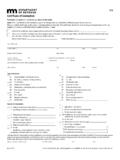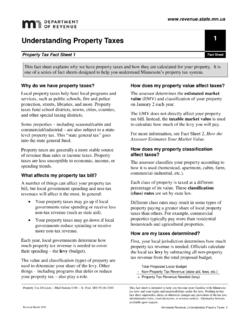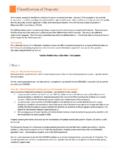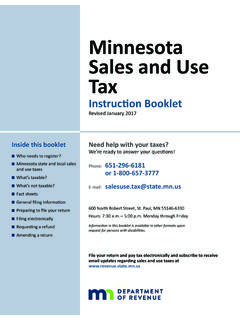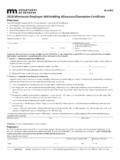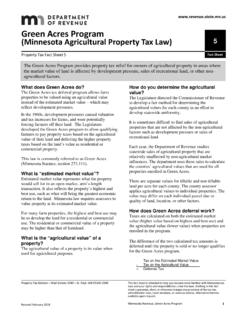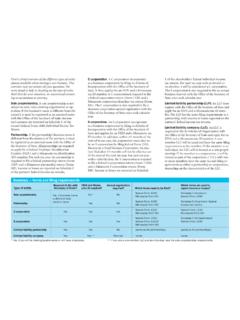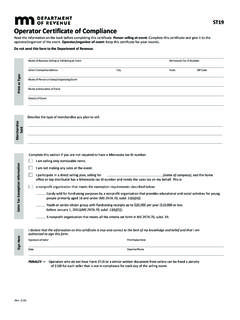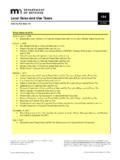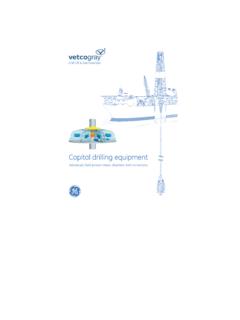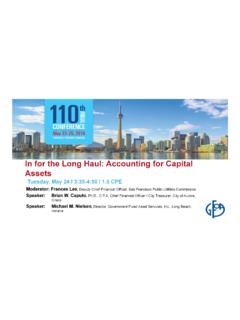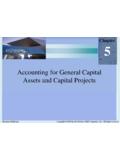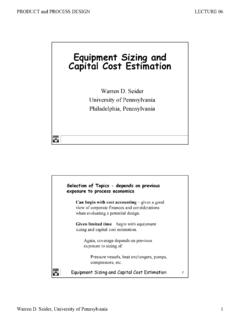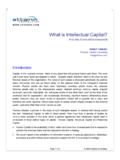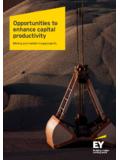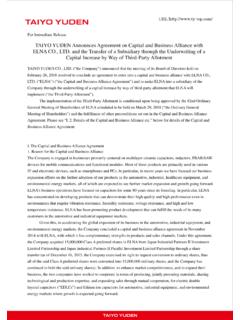Transcription of Capital Equipment 103 - Minnesota Department of Revenue
1 Sales and Use Tax Division Mail Station 6330 St. Paul, MN 55146-6330 Phone: 651-296-6181 Email: This fact sheet is intended to help you become more familiar with Minnesota tax laws and your rights and responsibilities under the laws. Nothing in this fact sheet supersedes, alters, or otherwise changes any provisions of the tax law, administrative rules, court decisions, or Revenue notices. Alternative formats available upon request. Stock No. 2800103, Revised June 2015 Minnesota Revenue , Capital Equipment Capital Equipment 103 Fact Sheet Sales Tax Fact Sheet 103 What s New in 2015 On July 1, 2015, Minnesota will change to an up-front sales tax exemption on eligible Capital Equipment pur-chases. For purchases before that date, you must continue to pay sales tax and then request a refund as described in this fact sheet.
2 For purchases beginning July 1, 2015, you will receive an exemption at the time of purchase. If you pay sales tax af-ter that date, you can still request a refund. If you buy or lease qualifying Capital Equipment for use in Minnesota , you are eligible for an exemption or a refund of state and local sales or use tax you paid. This fact sheet ex-plains how Minnesota sales and use tax applies to Capital Equipment . For information on Capital Equipment for on-line data retrieval systems request Revenue Notice 06-03. Capital Equipment means machinery and Equipment pur-chased or leased, and used in Minnesota by the purchaser or lessee primarily for manufacturing, fabricating, mining, or refining tangible personal property to be sold ultimately at retail if the machinery and Equipment are essential to the in-tegrated production process of manufacturing, fabricating, mining, or refining.
3 Capital Equipment also includes ma-chinery and Equipment used primarily to electronically transmit results retrieved by a customer of an on-line com-puterized data retrieval system. To claim the exemption for eligible purchases beginning July 1, 2015, give the supplier a completed Form ST3, Cer-tificate of Exemption. Use exemption reason code for Capi-tal Equipment . To get a refund of sales or use tax paid for eligible pur-chases before July 1, 2015, file Form ST11, Sales and Use Tax Refund Request and Multiple Period Amended Return. You may also use this form to request a refund of any tax you paid in error on or after July 1. You may file no more than two Capital Equipment refund re-quests in a calendar year. Download the form from our web-site or call our office to request one.
4 A refund request must be filed within 3 half years from the 20th day of the month following the month of the in-voice date or within one year of the date of an order as-sessing liability (if the liability has been paid in full), which-ever is longer. Any business may qualify for exemption on qualifying Equipment used primarily to make a product for sale ulti-mately at retail. For example, a hardware store may claim exemption for a key-making machine the key making ma-chine qualifies as Capital Equipment even though the main business of a hardware store is not manufacturing. Capital Equipment includes, but is not limited to: machinery and Equipment used to operate, control, or reg-ulate the production Equipment machinery and Equipment used for research and develop-ment, design, quality control, and testing activities environmental control devices that are used to maintain conditions such as temperature, humidity, light, or air pressure when those conditions are essential to and are part of the production process materials and supplies used to construct and install ma-chinery or Equipment repair and replacement parts, including accessories, whether purchased as spare parts, repair parts.
5 Or as up-grades or modifications to machinery or Equipment delivery and installation charges for qualifying Equipment materials used for foundations that support machinery or Equipment materials used to construct and install special purpose buildings used in the production process ready-mixed concrete trucks where the ready-mixed con-crete is mixed as part of the delivery process. The pur-chase of a ready-mixed truck is exempt up-front from the sales tax on motor vehicles. Beginning July 1, 2015, the up-front exemption applies to leases of ready-mixed trucks or purchases of repair or replacement parts. The term Capital Equipment is not the same as Capital -ized assets. Items capitalized for accounting purposes do not automatically qualify as Capital Equipment .
6 Items that you expense for accounting purposes, such as leased Equipment , may be considered Capital Equipment . 2 Minnesota Revenue , Capital Equipment Capital Equipment does not include: farm machinery, aquaculture and logging Equipment motor vehicles taxed under Minnesota Statutes, section 297B (vehicles for road use) building materials that become part of a general building structure or that are an addition, repair, improvement or alteration to real property (see page 4 for more infor-mation about building materials) machinery or Equipment used to receive or store raw ma-terials machinery or Equipment used in the transportation, trans-mission or distribution of petroleum, liquefied gas, natu-ral gas, steam or water through pipes, lines tanks or mains telecommunications Equipment and wire, cable, fiber, poles, or conduit used to provide telecommunications ser-vices machinery or Equipment used in restaurants to furnish, prepare or serve prepared food machinery or Equipment used to provide the following taxable services.
7 Laundry and dry cleaning services motor vehicle washing, waxing and cleaning services building and residential cleaning, maintenance, and disinfecting and exterminating services detective, security, burglar, fire alarm and armored car services pet grooming services lawn care, fertilizing, mowing, spraying and sprigging services; garden planting and maintenance; tree, bush, and shrub pruning, bracing, spraying, and surgery; in-door plant care; tree, bush, shrub and stump removal; and tree trimming for public utility lines furnishing lodging, board, and care services for ani-mals in kennels and other similar arrangements machinery or Equipment used for nonproduction purposes (see Non-qualifying activities on page 3) any other item that is not essential to the integrated pro-cess of manufacturing, fabricating, mining, or refining Definition of terms (as they relate to Capital Equipment ) Accessories to Capital Equipment are items that cannot function inde-pendently but are attached, connected or fastened to a piece of Equipment in order to function.
8 Accessories include feeders, tools, jigs, patterns, dies and molds. Accessories also include de-vices that upgrade, modernize or mod-ify the capabilities of the underlying Equipment . Equipment and machinery mechani-cal, electronic, or electrical devices, tools or hand tools. It includes comput-ers and software used to operate quali-fying Equipment , as well as any sub-unit or assembly of the Equipment . De-vices necessary to control, regulate, or operate the production Equipment are also included. Essential means that the Equipment must perform a necessary or indispen-sable step in the production process. The fact that a particular piece of Equipment is required by law or is a practical necessity does not make it es-sential to the production process.
9 Fabricating is making or assembling components to work in a new or differ-ent manner. Foundations qualify if they are the base or support structure necessary for qualifying Equipment . It does not in-clude the foundation for a building un-less the building is a special purpose building. Manufacturing is changing the form, composition, or condition of raw materi-als into a new product. For purposes of the Capital Equipment exemption, man-ufacturing includes generating electric-ity or steam for sale at retail. Manufac-turing includes converting an unusable item into a useful item through rebuild-ing or reconstruction for sale at retail. Manufacturing does not include repair or refurbishing items returned to the original owner. Materials and supplies are items nec-essary to construct or install qualifying Capital Equipment , such as nails, bolts, screws, pipes, lumber, and wire used to secure or assemble the Equipment in the facility.
10 Mining is extracting ore, minerals, or peat from the earth. It includes under-ground, surface, and open-pit mining operations. It also includes any surface mining to obtain building stone, lime-stone, gravel, sand, or other surface materials. On-line data retrieval system means a computerized system whose data-base of information is equally available and accessible to all customers. Pollution control Equipment is used to eliminate, prevent, or reduce pollu-tion resulting from production activities. Primarily means that the Equipment must be used 50 percent or more of its operating time in a qualifying activity. Product, for purposes of this fact sheet, means tangible personal prop-erty, electricity and steam. Refining means converting natural re-sources to a product; purifying materi-als such as oil, metal, sugar, and fats; and treating of water to be sold at re-tail.
